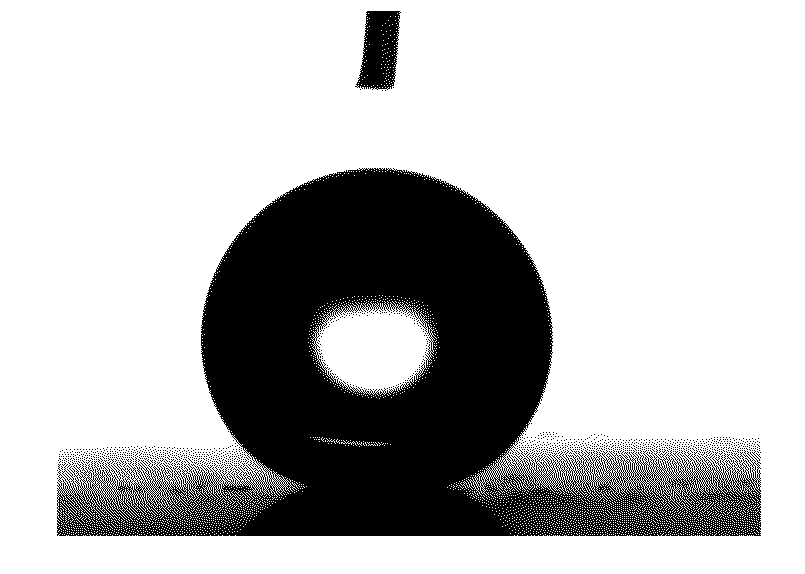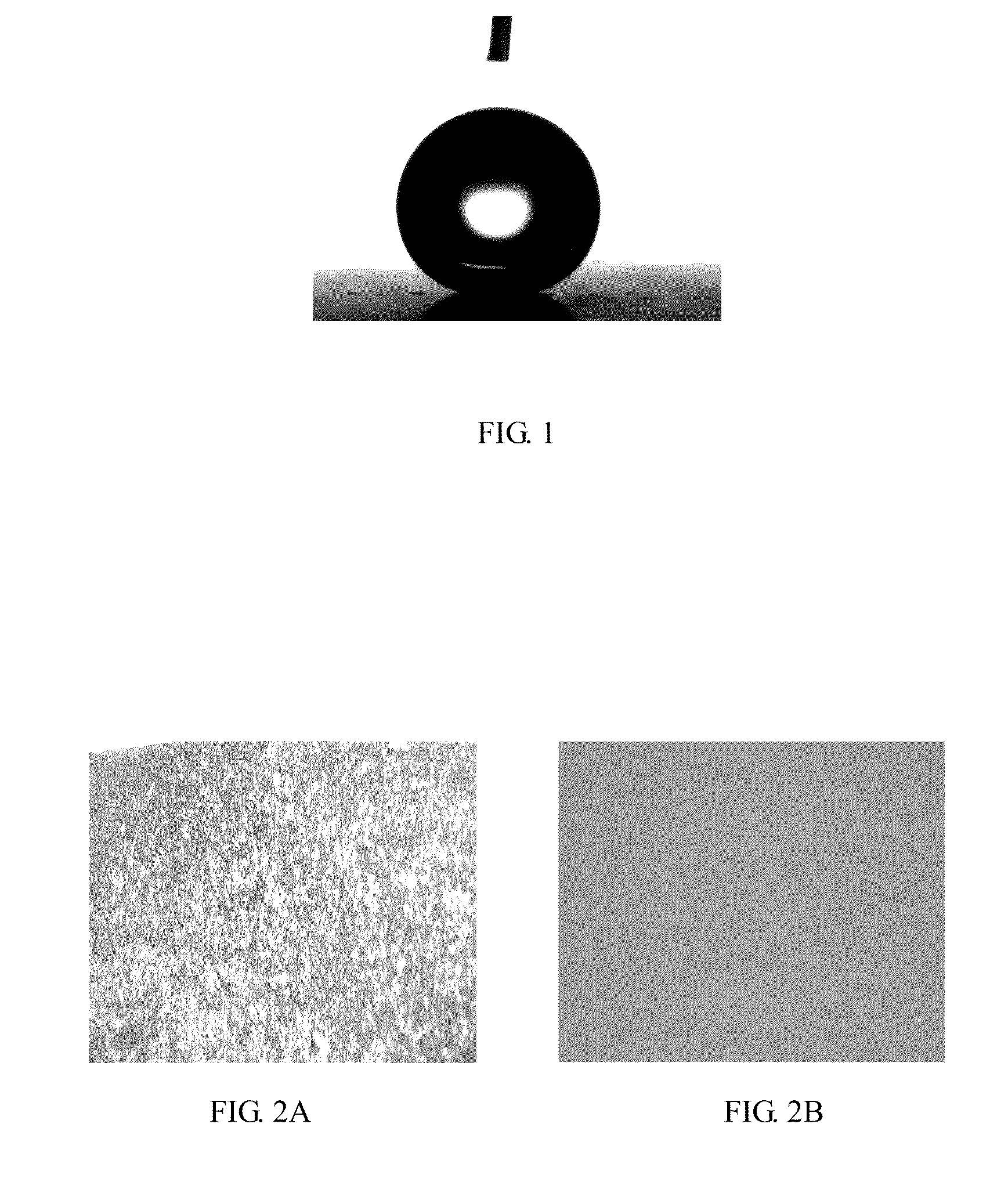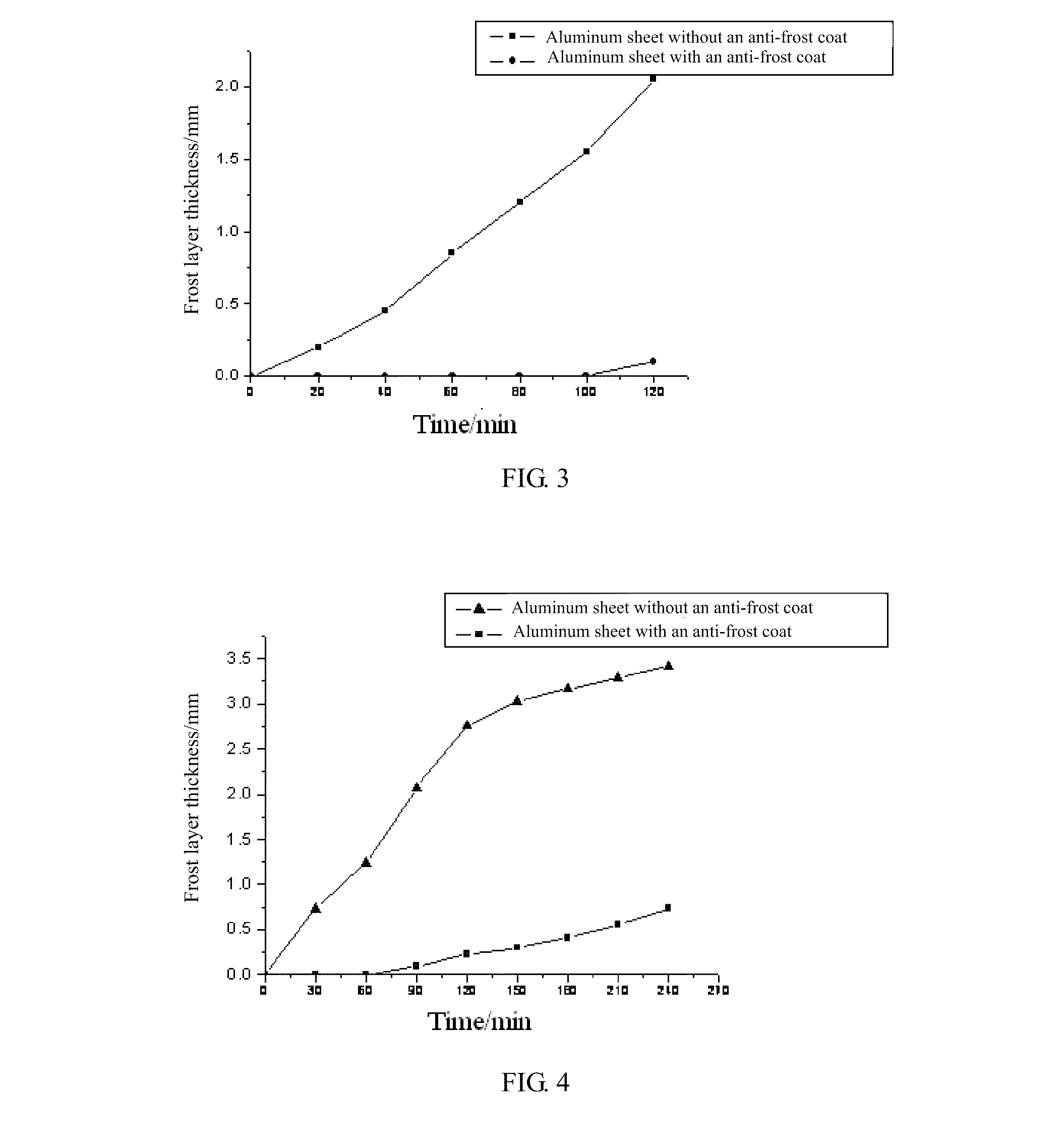Anti-frost coating and the application method thereof
a technology of anti-frost coating and application method, which is applied in the field of refrigeration energy conservation, can solve the problems of low heat transfer efficiency of equipment, huge energy waste, and low operating efficiency of refrigerating equipmen
- Summary
- Abstract
- Description
- Claims
- Application Information
AI Technical Summary
Benefits of technology
Problems solved by technology
Method used
Image
Examples
example 1
1. Preparation of a Hydrophilic Polymer
[0041]Compositions: Sodium acrylate 20 g and 2-hydroxyethyl methacrylate 10 g.
[0042]Mix monomers sodium acrylate 20 g and 2-hydroxyethyl methacrylate 10 g to obtain mixed monomer A1. Add 160 g of water into a container equipped with a reflux condenser, a stirrer and a dropping funnel, add 21 g of the mixed monomer A1 at first under the atmosphere of nitrogen, raise temperature to 60° C., add 0.25 g of ammonium persulphate as initiator and 0.2 g of sodium bicarbonate as pH regulator, and in 10 min add the remaining mixed monomer A1; after reacting for 4 hours, add 0.05 g of ammonium persulphate as initiator, continue to react for 2 hours, dewater the products after completion of the reaction, and vacuum dry to obtain a hydrophilic polymer. The hydrophilic polymer has a number-average molecular weight measured gel permeation chromatography (GPC) of 5.6×105. The static contact angle between water and the smooth film obtained by using water as solv...
example 2
[0051]1. Commercial polyacrylic acid (number-average molecular weight is 1.01×107) and poly(2-hydroxyethyl methacrylate) (number-average molecular weight is 1.3×105) are purchased. The hydrophilic polymer is a mixture of polyacrylic acid and poly(2-hydroxyethyl methacrylate). The static contact angle between the smooth film prepared from this mixture and water is smaller than 5°.
[0052]2. Preparation of a hydrophobic polymer
[0053]Mix 15 g of hexafluorobutyl acrylate and 20 g of methyl methacrylate to obtain a mixed monomer B2.
[0054]Add 60 ml of butyl acetate into a container equipped with a reflux condenser, a stirrer and a dropping funnel, add 24.5 g of monomer B2 at first under the atmosphere of nitrogen, raise temperature to 70° C., add 0.07 g of benzoyl peroxide as initiator, and in 10 min add the remaining mixed monomer B2; after reacting for 4 hours, add 0.03 g of benzoyl peroxide as initiator, continue to react for 2 h, remove the solvent from the product after completion of t...
example 3
[0058]1. Commercial polyacrylic acid is chosen as a hydrophilic polymer. The static contact angle between its smooth film and water is smaller than 5°.
[0059]2. Commercial polypropylene is chosen as a hydrophobic polymer. The static contact angle between its smooth film and water is 102.5°.
[0060]3. Application of the anti-frost coating and the adjustment of hydrophilic / super-hydrophobic composite structure
[0061]Weigh 20 g of polyacrylic acid (number-average molecular weight is 8×106) and 10 g of polypropylene (number-average molecular weight is 4.95×106), mix them well, dissolve the mixture in the mixed solvent of dioxane and xylene (v / v 2:1) at 120° C. to obtain an anti-frost coating containing 10 wt % polymer and apply the coating on the surface of an aluminum sheet by natural flowing technique. Dry and cure the coated aluminum sheet at 40° C. under 1000 Pa. An aluminum sheet with an anti-frost coat is obtained. The inner layer of the anti-frost coat is a hydrophilic polyacrylic ac...
PUM
| Property | Measurement | Unit |
|---|---|---|
| Pressure | aaaaa | aaaaa |
| Contact angle | aaaaa | aaaaa |
| Temperature | aaaaa | aaaaa |
Abstract
Description
Claims
Application Information
 Login to View More
Login to View More - R&D
- Intellectual Property
- Life Sciences
- Materials
- Tech Scout
- Unparalleled Data Quality
- Higher Quality Content
- 60% Fewer Hallucinations
Browse by: Latest US Patents, China's latest patents, Technical Efficacy Thesaurus, Application Domain, Technology Topic, Popular Technical Reports.
© 2025 PatSnap. All rights reserved.Legal|Privacy policy|Modern Slavery Act Transparency Statement|Sitemap|About US| Contact US: help@patsnap.com



